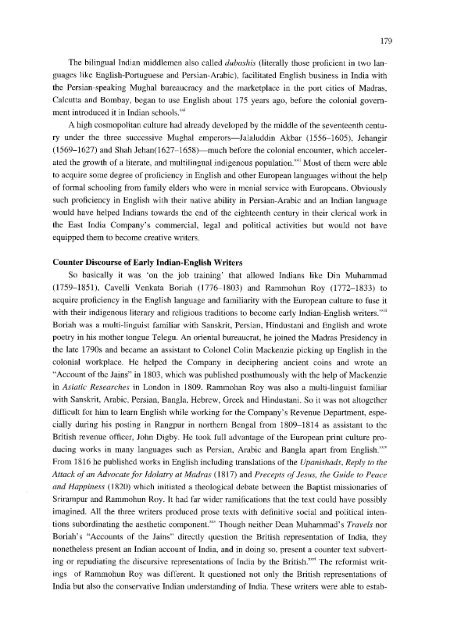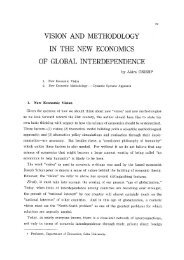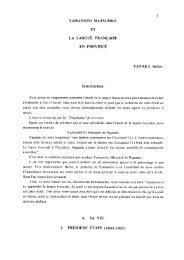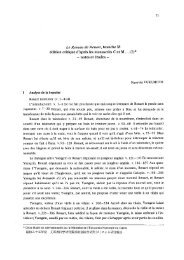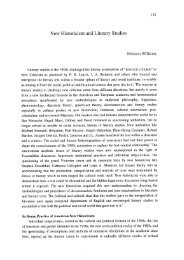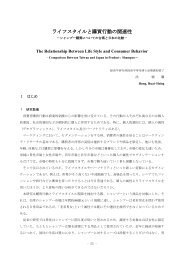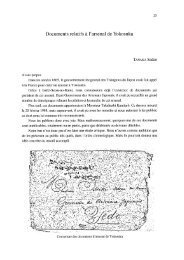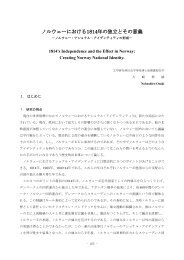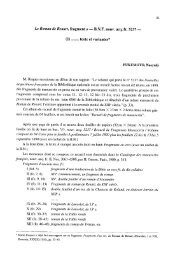Indian Writing in English 1794-2004 - Soka University Repository
Indian Writing in English 1794-2004 - Soka University Repository
Indian Writing in English 1794-2004 - Soka University Repository
You also want an ePaper? Increase the reach of your titles
YUMPU automatically turns print PDFs into web optimized ePapers that Google loves.
The bil<strong>in</strong>gual <strong>Indian</strong> middlemen also called dubashis (literally those proficient <strong>in</strong> two lan-<br />
guages like <strong>English</strong>-Portuguese and Persian-Arabic), facilitated <strong>English</strong> bus<strong>in</strong>ess <strong>in</strong> India with<br />
the Persian-speak<strong>in</strong>g Mughal bureaucracy and the marketplace <strong>in</strong> the port cities of Madras,<br />
Calcutta and Bombay, began to use <strong>English</strong> about 175 years ago, before the colonial govern-<br />
ment <strong>in</strong>troduced it <strong>in</strong> <strong>Indian</strong> schools."'<br />
A high cosmopolitan culture had already developed by the middle of the seventeenth centu-<br />
ry under the three successive Mughal emperors—Jalaludd<strong>in</strong> Akbar (1556-1605), Jehangir<br />
(1569-1627) and Shah Jehan(1627-1658)—much before the colonial encounter, which acceler-<br />
ated the growth of a literate, and multil<strong>in</strong>gual <strong>in</strong>digenous population.' Most of them were able<br />
to acquire some degree of proficiency <strong>in</strong> <strong>English</strong> and other European languages without the help<br />
of formal school<strong>in</strong>g from family elders who were <strong>in</strong> menial service with Europeans. Obviously<br />
such proficiency <strong>in</strong> <strong>English</strong> with their native ability <strong>in</strong> Persian-Arabic and an <strong>Indian</strong> language<br />
would have helped <strong>Indian</strong>s towards the end of the eighteenth century <strong>in</strong> their clerical work <strong>in</strong><br />
the East India Company's commercial, legal and political activities but would not have<br />
equipped them to become creative writers.<br />
Counter Discourse of Early <strong>Indian</strong>-<strong>English</strong> Writers<br />
So basically it was `on the job tra<strong>in</strong><strong>in</strong>g' that allowed <strong>Indian</strong>s like D<strong>in</strong> Muhammad<br />
(1759-1851), Cavelli Venkata Boriah (1776-1803) and Rammohun Roy (1772-1833) to<br />
acquire proficiency <strong>in</strong> the <strong>English</strong> language and familiarity with the European culture to fuse it<br />
with their <strong>in</strong>digenous literary and religious traditions to become early <strong>Indian</strong>-<strong>English</strong> writers:—<br />
Boriah was a multi-l<strong>in</strong>guist familiar with Sanskrit, Persian, H<strong>in</strong>dustani and <strong>English</strong> and wrote<br />
poetry <strong>in</strong> his mother tongue Telegu. An oriental bureaucrat, he jo<strong>in</strong>ed the Madras Presidency <strong>in</strong><br />
the late 1790s and became an assistant to Colonel Col<strong>in</strong> Mackenzie pick<strong>in</strong>g up <strong>English</strong> <strong>in</strong> the<br />
colonial workplace. He helped the Company <strong>in</strong> decipher<strong>in</strong>g ancient co<strong>in</strong>s and wrote an<br />
"Account of the Ja<strong>in</strong>s" <strong>in</strong> 1803 , which was published posthumously with the help of Mackenzie<br />
<strong>in</strong> Asiatic Researches <strong>in</strong> London <strong>in</strong> 1809. Rammohan Roy was also a multi-l<strong>in</strong>guist familiar<br />
with Sanskrit, Arabic, Persian, Bangla, Hebrew, Greek and H<strong>in</strong>dustani. So it was not altogether<br />
difficult for him to learn <strong>English</strong> while work<strong>in</strong>g for the Company's Revenue Department, espe-<br />
cially dur<strong>in</strong>g his post<strong>in</strong>g <strong>in</strong> Rangpur <strong>in</strong> northern Bengal from 1809-1814 as assistant to the<br />
British revenue officer, John Digby. He took full advantage of the European pr<strong>in</strong>t culture pro-<br />
duc<strong>in</strong>g works <strong>in</strong> many languages such as Persian, Arabic and Bangla apart from <strong>English</strong>.Xx`"<br />
From 1816 he published works <strong>in</strong> <strong>English</strong> <strong>in</strong>clud<strong>in</strong>g translations of the Upanishads, Reply to the<br />
Attack of an Advocate for Idolatry at Madras (1817) and Precepts of Jesus, the Guide to Peace<br />
and Happ<strong>in</strong>ess (1820) which <strong>in</strong>itiated a theological debate between the Baptist missionaries of<br />
Srirampur and Rammohun Roy. It had far wider ramifications that the text could have possibly<br />
imag<strong>in</strong>ed. All the three writers produced prose texts with def<strong>in</strong>itive social and political <strong>in</strong>ten-<br />
tions subord<strong>in</strong>at<strong>in</strong>g the aesthetic component.XX" Though neither Dean Muhammad's Travels nor<br />
Boriah's "Accounts of the Ja<strong>in</strong>s" directly question the British representation of India, they<br />
nonetheless present an <strong>Indian</strong> account of India, and <strong>in</strong> do<strong>in</strong>g so, present a counter text subvert-<br />
<strong>in</strong>g or repudiat<strong>in</strong>g the discursive representations of India by the British.XX"' The reformist writ-<br />
<strong>in</strong>gs of Rammohun Roy was different. It questioned not only the British representations of<br />
India but also the conservative <strong>Indian</strong> understand<strong>in</strong>g of India. These writers were able to estab-<br />
179


